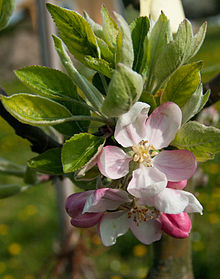Alkmene (apple)
| Alcmene | |
|---|---|

|
|
| Art | Cultivated apple ( Malus domestica ) |
| origin | Müncheberg , Germany |
| Institute | Institute for Arable and Crop Production in Müncheberg |
| Breeding year | 1930 |
| ancestry | |
|
Cross of |
|
| List of apple varieties | |
Alkmene is a cultivar of the cultivated apple . It was bred to be grown in drier climates as a replacement for the ' Cox Orange '. The cross between Cox Orange and ' Privy Councilor Dr. Oldenburg 'is ready for picking in Europe in early autumn at the beginning / middle of September.
In commercial cultivation, alkmene is planted primarily because of its taste and the price that can be achieved with it, although the yields do not come close to other varieties.
description
The tree grows rather weakly. The fruit is small to medium-sized and round with a golden-yellow, orange-red faded skin.
The flesh is greenish-yellow to cream-colored, firm, fine-celled and crisp. The aroma of Alkmene is slightly acidic, diverse and has hints of Cox Orange.
Cultivation
Alkmene needs a mild, slightly shady location where the flowers are not affected by late frosts. Medium altitudes or slightly shady vineyards have proven to be optimal . In contrast to the parent variety Cox Orange, Alkmene copes well with moderately dry to moderately fresh clay soils of medium fertility. The apple also tolerates wind. The diploid variety is well fertilized by ' Cox Orangenrenette ', ' Golden Delicious ' and ' James Grieve '.
The flowering period begins in late April and ends in mid-May. Alkmene flowers very richly, but there is only a moderate fruit yield. The flowers are at least moderately sensitive to frost, the tree itself can withstand strong winter frosts. If the sunlight is too strong, the fruit skin can tear open.
The yield is roughly two thirds of the yield from Golden Delicious .
Ripe for picking is from the beginning of September to mid-September, and consumption is from September to the end of October. Even in the cold store, 'Alkmene' only lasts until the end of November, as temperatures below two degrees pose a risk of meat browning.
Vulnerabilities and resistances
Alkmene is not sensitive to scab and powdery mildew , but is susceptible to fire blight , collar rot , cancers and red spider . The tree is sensitive to sulfur.
Mutants
The mutants Cevaal, which was discovered in the Netherlands in 1982, and a mutant by De Coster from Belgium are common. With otherwise similar behavior, both are colored more red than the original form.
history
The crossing of Alkmene from Cox Orange and Privy Councilor Dr. Oldenburg was one of the first works by the Kaiser Wilhelm Institute for Plant Breeding Research in Müncheberg, which later became the Max Planck Institute for Plant Breeding Research . The aim was to breed a variety similar to the Cox Orange that can be grown in areas with a drier summer climate than that in England.
The apple has been commercially grown in Germany since 1960, and around 1,000 tons were harvested annually in the 1990s. The main growing regions are the Lake Constance region and the area around the Neckar .
Remarks
- ↑ a b c d Robert Silbereisen, Gerhard Götz, Walter Hartmann: Obstsorten-Atlas . Verlag Eugen Ulmer, Stuttgart 1996, ISBN 3-8001-5537-0 , p. 26
- ↑ a b c d e f Robert Silbereisen, Gerhard Götz, Walter Hartmann: Obstsorten-Atlas . Verlag Eugen Ulmer, Stuttgart 1996, ISBN 3-8001-5537-0 , p. 24
- ^ Robert Silbereisen, Gerhard Götz, Walter Hartmann: Obstsorten-Atlas . Verlag Eugen Ulmer, Stuttgart 1996, ISBN 3-8001-5537-0 , p. 25
literature
- Manfred Fischer (Ed.): Color Atlas of Fruit Types . Ulmer Verlag, Stuttgart, 2nd edition 2003, ISBN 3-8001-5547-8 , p. 39.
- Gerhard Friedrich , Herbert Petzold : Handbook of fruit varieties . Ulmer Verlag, Stuttgart 2005, ISBN 3-8001-4853-6 , p. 18.
Web links
- The Alkmene variety from the Association of Servants for Fruit Growing, Gardening and Landscape Baden-Württemberg (accessed on May 21, 2012)


